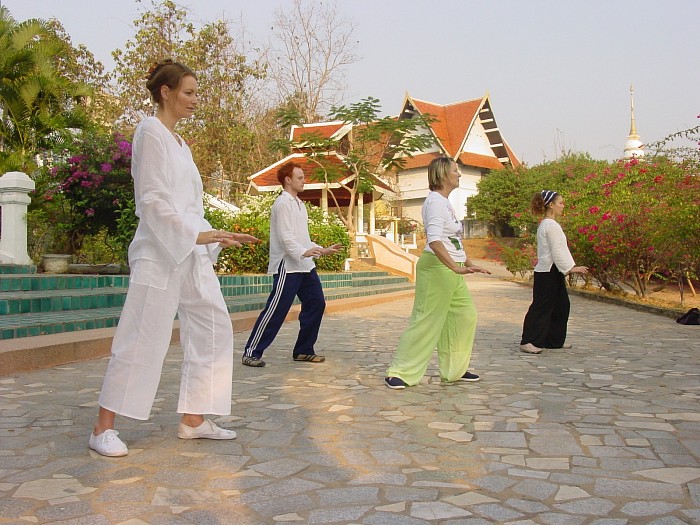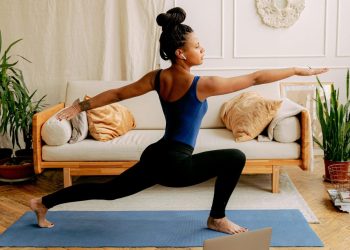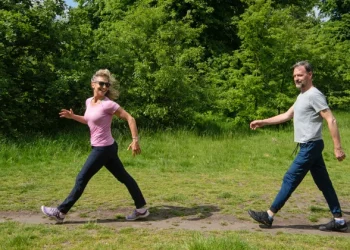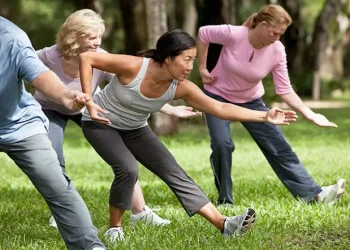Tai Chi, the ancient Chinese martial art and movement practice, is renowned for its slow, deliberate movements and profound health benefits. At the heart of this practice lies a fundamental yet often overlooked element: walking posture. Unlike ordinary walking, Tai Chi walking requires a specific alignment and awareness that transforms each step into a meditation in motion. Understanding and mastering proper Tai Chi walking posture is essential for practitioners at any level, as it forms the foundation upon which all other movements are built.
The Philosophy Behind Tai Chi Walking
Before delving into the technical aspects of posture, it’s important to understand the underlying philosophy. Tai Chi walking, or “walking meditation,” embodies the principle of moving as if through water—with smoothness, continuity, and rootedness. The practice emphasizes the connection between mind, body, and breath, requiring practitioners to remain present and aware of every subtle shift in weight and position. This mindful approach to walking cultivates internal energy (qi) circulation, improves balance, and develops the deep postural awareness necessary for advanced Tai Chi practice.
Proper Posture Alignment: The Essential Components
Head and Neck Positioning
The foundation of correct Tai Chi walking posture begins at the crown of the head. Imagine a string gently pulling the crown upward toward the sky, creating a natural lengthening of the spine. This visualization, known as “suspending the head from above,” helps maintain proper cervical alignment. The chin should be slightly tucked, not jutting forward or pressed too far back against the throat. This neutral position allows the neck vertebrae to stack naturally, reducing tension and promoting free energy flow.
The gaze should be soft and directed naturally forward, neither fixed nor wandering. Eyes remain open but relaxed, maintaining peripheral awareness while focusing on a point approximately 10 to 15 feet ahead. This soft gaze prevents neck strain and maintains the meditative quality of the practice.
Shoulder and Arm Alignment
The shoulders play a crucial role in Tai Chi walking posture. They should be relaxed, dropped, and settled, neither hunched forward nor pulled backward. Many practitioners make the mistake of holding tension in the shoulder girdle, which blocks energy flow and creates discomfort. Think of the shoulders as melting downward while the head continues to lift, creating a gentle lengthening through the spine.
The arms hang naturally at the sides with elbows slightly bent, never locked straight. There should be a small space under the armpits, as if holding a soft ball. This arm position, called “embracing space,” maintains openness in the chest and allows for unrestricted breathing. The hands remain soft and relaxed, fingers gently curved, neither clenched nor overly limp.
Spine and Torso Alignment
The spine should maintain its natural curves while achieving an overall sense of vertical alignment. Imagine the spine as a string of pearls, each vertebra stacking smoothly on the one below. The lower back should not be overly arched or flattened; instead, maintain a neutral lumbar curve by gently engaging the lower abdominal muscles.
The chest remains soft and slightly concave, never puffed out. This “hollowing the chest” principle prevents upper body tension and encourages the qi to sink to the lower dan tian (energy center located approximately three finger-widths below the navel). The torso should feel upright yet relaxed, like a tree trunk—rooted below and reaching above, but flexible enough to move with the wind.
Hip and Pelvic Alignment
Proper hip alignment is critical for Tai Chi walking. The pelvis should be in a neutral position, neither tilted forward (anterior tilt) nor backward (posterior tilt). A helpful cue is to imagine tucking the tailbone slightly forward and downward, as if sitting on the edge of a high stool. This subtle adjustment prevents excessive lordosis and helps engage the core muscles.
The hips should remain level and parallel to the ground throughout the walking motion. Weight shifts occur smoothly from side to side, but the pelvis remains stable, not swaying or bobbing. This stability comes from proper leg work and core engagement rather than hip movement.
Leg and Foot Placement
The legs are the roots of Tai Chi walking, and their positioning determines overall stability and grace. When stepping, lift the foot by raising from the hip, keeping the knee slightly bent and relaxed. The foot should lift only as high as necessary to clear the ground comfortably—excessive lifting wastes energy and compromises balance.
Place the foot down heel first, then gently roll through the outer edge to the ball of the foot, and finally settle the entire sole flat on the ground. This rolling motion creates a smooth weight transfer and maintains constant contact with the earth. The knees should always track over the toes, never collapsing inward or bowing outward.
The stance width is approximately shoulder-width apart, providing a stable base without compromising mobility. Feet remain parallel or turned out very slightly, typically no more than 10 to 15 degrees. The weight distribution shifts from 70-30 to 100-0 between feet as you step, creating the characteristic substantial and insubstantial dynamic of Tai Chi.
Common Posture Mistakes and Their Corrections
Forward Head Posture
One of the most prevalent mistakes is allowing the head to jut forward, especially as fatigue sets in. This misalignment places tremendous strain on the neck muscles and upper back, disrupting the flow of energy. Practitioners often develop this habit from daily activities like computer work or smartphone use.
Correction: Regularly check that your ears align vertically with your shoulders. Practice the “suspended head” visualization throughout your walking practice. If you notice your head drifting forward, pause, reset your alignment, and continue mindfully.
Raised or Tense Shoulders
Many beginners unconsciously raise their shoulders toward their ears, creating unnecessary tension that radiates throughout the body. This tension not only causes discomfort but also restricts breathing and energy circulation.
Correction: Before each practice session, perform shoulder rolls and conscious relaxation. During walking, periodically remind yourself to “drop” the shoulders. Imagine them as heavy weights melting downward. Take deep breaths and consciously release shoulder tension with each exhalation.
Locked Knees
Standing or walking with locked knees is a common error that compromises stability and joint health. Locked knees create rigidity throughout the leg chain and prevent the smooth weight transfers essential to Tai Chi walking.
Correction: Maintain a micro-bend in the knees at all times, even when the leg is nominally “straight.” This slight flexion keeps the joints soft and responsive. Think of your legs as springs that can compress and expand rather than rigid posts.
Swaying Hips or Bobbing Motion
Some practitioners develop an exaggerated hip sway or a bouncing, bobbing motion as they walk. This typically results from improper weight transfer or failure to maintain core engagement.
Correction: Focus on moving from your center rather than from your legs alone. Engage the lower abdominal muscles to stabilize the pelvis. Practice walking in front of a mirror or record yourself to identify unwanted movement. The crown of the head should travel in a smooth, level path as you walk, not bobbing up and down.
Flat Footed Stepping
Stepping flat-footed, landing the entire sole simultaneously, creates jarring impacts and prevents smooth weight transfer. This harsh stepping disrupts the meditative flow and can lead to knee problems over time.
Correction: Practice the heel-to-toe rolling motion consciously and slowly. Exaggerate the rolling initially until it becomes natural. Imagine your foot as a wheel rolling smoothly along the ground.
Overreaching or Understeping
Taking steps that are too long overextends the body and compromises balance, while steps that are too short create a shuffling, unstable gait.
Correction: Find your natural step length through experimentation. A good rule of thumb is that your front knee should align approximately over your front ankle when you complete a step with full weight transfer. Adjust gradually until you find a comfortable, stable stride length.
Maintaining Correct Positioning: Practice Strategies
Develop Body Awareness Through Stillness
Before working on walking, spend time in standing meditation (Zhan Zhuang). Stand in proper alignment for 5-10 minutes daily, scanning your body from head to toe. This stillness practice develops the proprioceptive awareness necessary to maintain correct positioning while moving.
Use External Feedback
Practice in front of a mirror or record videos of your walking practice. External feedback helps you identify discrepancies between how you think you’re moving and how you’re actually moving. Consider working with a qualified instructor who can provide personalized corrections.
Implement Alignment Checkpoints
Develop a mental checklist to run through periodically during practice: crown lifted, chin tucked, shoulders dropped, chest soft, spine elongated, pelvis neutral, knees soft, weight clear. Cycle through these checkpoints every few steps until correct alignment becomes habitual.
Practice Slowly and Mindfully
Speed is the enemy of proper form, especially for beginners. Practice at a pace that allows you to maintain full awareness of your alignment. As correct positioning becomes more natural, you can gradually increase speed while maintaining form.
Strengthen Supporting Muscles
Incorporate complementary exercises that strengthen the core, legs, and postural muscles. Planks, gentle squats, and balance exercises enhance the physical capacity to maintain proper alignment during Tai Chi walking.
Breathe Naturally and Fully
Proper breathing supports proper posture. Breathe deeply into the lower abdomen, allowing the breath to settle and the body to relax. Forced or shallow breathing creates tension that disrupts alignment. Let the breath be natural, full, and coordinated with your movement.
Be Patient and Compassionate with Yourself
Developing correct Tai Chi walking posture takes time—often months or years of consistent practice. Approach the process with patience and self-compassion. Each practice session is an opportunity to refine your understanding and execution, regardless of your current level.
Conclusion
Tai Chi walking posture represents far more than a simple alignment of body parts. It embodies the integration of physical structure, mental awareness, and energetic cultivation. By understanding proper alignment principles, recognizing common mistakes, and implementing consistent correction strategies, practitioners can develop a walking practice that serves as both meditation and medicine.
The journey toward mastering Tai Chi walking posture is ongoing, even for advanced practitioners. Each step offers an opportunity to deepen awareness, refine alignment, and cultivate the peaceful presence that is Tai Chi’s greatest gift. Whether you practice for health, martial application, or spiritual development, proper walking posture provides the foundation upon which all other aspects of Tai Chi rest.
Remember that correct posture should feel natural and comfortable, not forced or rigid. As you continue your practice, the principles of alignment will gradually integrate into your everyday movement, bringing the benefits of Tai Chi walking into all aspects of your life. With dedication, patience, and mindful attention, your walking practice will evolve from a series of technical adjustments into a fluid, graceful expression of mind-body unity.






